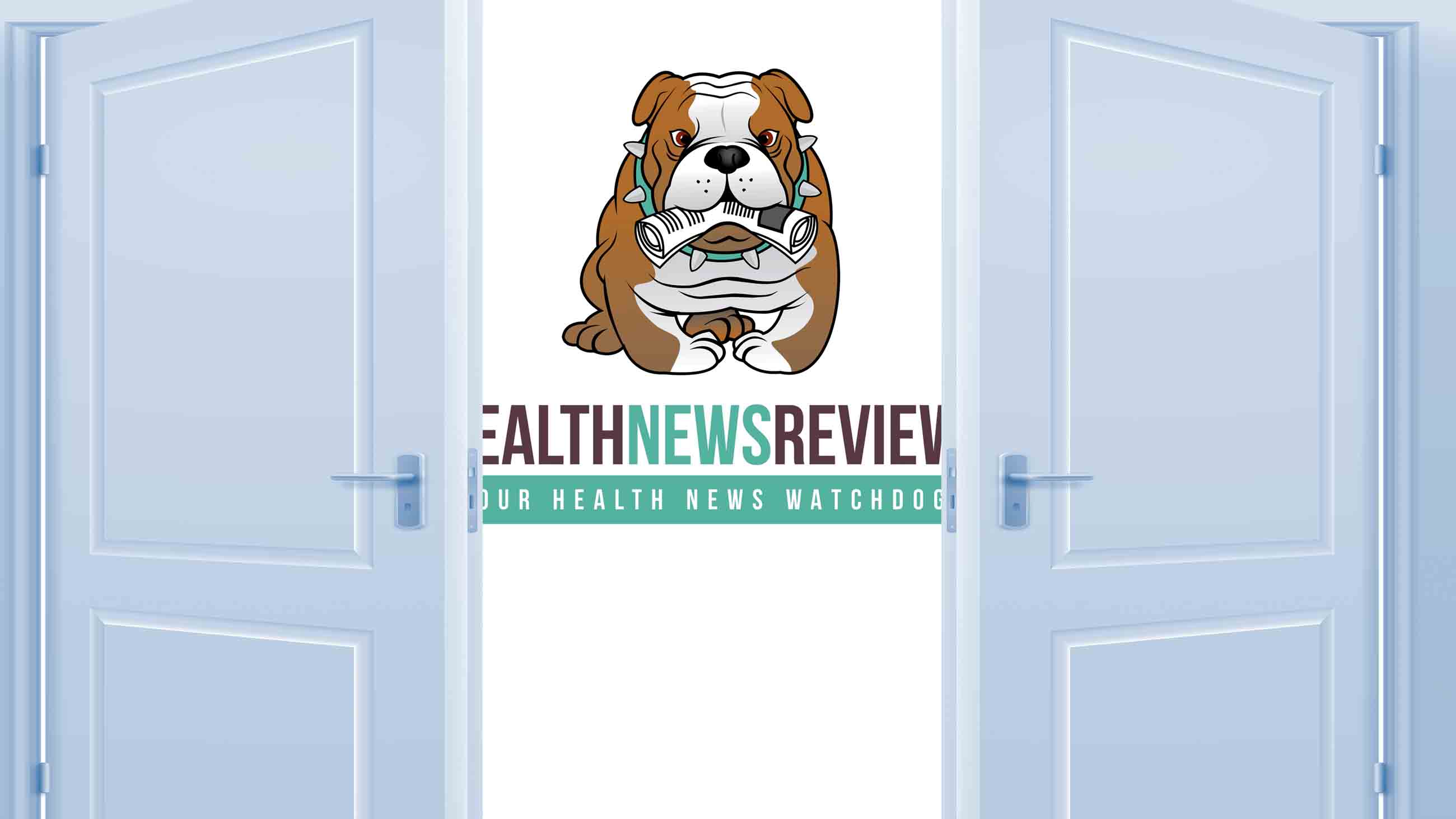With Funding Scarce, HealthNewsReview.org Hurtles Toward Closure
The widely-read media watchdog site, HealthNewsReview.org, announced last week that it will shut down operations at the end of the year unless a major funder steps forward. The closure would end a 12-year run for a website that has established a national reputation for its media criticism — and, along the way, garnered some critics of its own.

THE TRACKER
The Science Press Under the Microscope.
Gary Schwitzer, a former health care reporter for CNN and longtime professor of journalism at the University of Minnesota, launched HealthNewsReview.org in 2006, modeling it on a site called Media Doctor Australia. The site, which currently has five full-time employees and dozens of freelance contributors, serves as a clearinghouse for reasoned — and sometimes biting — critiques of health care and medical coverage in the news media, as well as its distillation to consumers through press releases and other marketing materials. The site also aggressively covers larger questions of influence and conflict-of-interest in journalism.
In a conversation with Undark, Schwitzer said that he had always imagined the site as more than just a media watchdog. “I always viewed it as trying to improve media messages, because that might be the low-hanging fruit … for us to improve the broader public dialogue.”
Today, Schwitzer says, HNR averages around 700,000 unique visitors per year — small numbers compared to major news sites, but substantial traffic for a niche publication, and its influence among many health care journalists — and the roughly 6,000 reporters, doctors, and consumer advocates who subscribe to the site’s weekly newsletter — has been substantial.
Said Julia Belluz, the senior health care correspondent for Vox, when asked for her thoughts on the potential shuttering of HNR: “It really will leave a big void.”
The work of HNR was originally funded by the Foundation for Informed Medical Decision Making, which later became the Informed Medical Decisions Foundation, which in turn merged with the nonprofit patient education and content company Healthwise. That funding source dried up in 2013, after which Schwitzer says he ran HNR for 19 months without any grant money, salary, or paid writers, an experience that, he says, he will not repeat. (HNR has around 50 freelance contributors — half of them working pro bono, Schwitzer said — in addition to its editorial staff.
HNR’s budget was rescued in 2014 with a $1.3 million, two-year grant from the Laura and John Arnold Foundation, a Houston-based foundation that aims to strengthen “social, governmental, and economic systems.” The funding allowed HNR to hire full-time staff besides Schwitzer, formalize a partnership with the University of Minnesota School of Public Health, and expand coverage. The foundation renewed the grant for another two years in 2016, but Schwitzer soon received indications that there may not be further funding, and the foundation opted not to renew the grant again. (Undark has contacted the Arnold Foundation for comment).
As it stands, HNR’s annual budget in recent years has run to $850,000 per year — and even then, Schwitzer said, money has been tight. To keep the site going, he estimated, would require at least a million dollars per year — a sum for which he has been trying to find another backer for more than a year, talking to at least 25 potential rainmakers.
To date, however, those conversations have not borne fruit.
“Nada,” Schwitzer said. “Crickets.”
HNR’s signature feature is a 10-point checklist of the criteria that, Schwitzer argues, every journalist ought to include when writing about new medical treatments — including the costs of the intervention, a comparison with existing treatments, and accurate distillation of the science backing it up. Based on the checklist, HNR and its contributors have rated thousands of news articles, giving each a score from one to five stars. Schwitzer has worked hard to popularize the checklist, even distributing mousepads with the criteria printed on them.
After Schwitzer announced HealthNewsReview’s funding problems last week, dozens of journalists, physicians, and patient advocates took to Twitter to lament the possibility that the site might end.
Belluz told me that she and her colleagues “really took those reviews to heart.” Noting the high stakes of health care reporting — and the consequences of making mistakes — Belluz described HNR as “an important watchdog.”
“There’s nothing else that’s really like that,” she added.
Ivan Oransky, the editor of Retraction Watch and the current president of the Association of Health Care Journalists, told me that he uses the 10-point checklist in journalism classes he teaches at NYU, asking students to rate articles as if they were HNR reviewers. He would distribute the checklist to staff, too, when he worked at Reuters. “It’s really a lighthouse warning health care reporters about the shallow waters,” Oransky said. “I think it’ll be a big loss if this really means the end for HealthNewsReview.”
The site is not universally popular among health care journalists. “I will not mourn the disappearance of HealthNewsReview,” said Maggie Fox, a senior health writer at NBC News, in an interview with Undark. “I don’t think they ever did the job well,” she said, describing the site’s tone as “mean-spirited.”
Fox did stress the value of media criticism in general. But, she argued, HNR’s approach had done too little to engage with journalists about their work — by not seeking comment, for example, before publishing criticisms — and its criteria were not realistic for all stories in all newsrooms. “Their demands are for very long, very wordy stories with a lot of background information in them, without taking into account that many organizations have word count limits, and that understandability for whoever your audience is,” Fox told me, “you might not need or want all that detail in there.”
For his part, Schwitzer defends the site’s method. “This is not a beat where people want briefs. This is a beat where people want in-depth, analytical background context,” he said. “You got a better set of criteria? Let’s hear it. But I can tell you, in 12 years, nobody has come up with anything.”
In response to suggestions that the site was mean-spirited, Schwitzer pointed to the site’s weekly roundups of five-star coverage, as well as to the warm messages that he has received since announcing the site’s impending closure. “If this were mean-spirited, why the hell would I do this every day, for 12 years?” he said. “Because I get my jollies from that?”
Certainly, at a time of rampant misinformation online, the site’s imminent closure is likely to leave a niche unfilled. While some science-oriented publications — including Undark — publish media criticism, HNR is unique in having a staff devoted to monitoring public conversations about health care and health science.
“The sad thing is that I don’t see anything on the horizon that’s going to replace us,” said Schwitzer. “We’re going to see the same patterns of polluted messages and recurring flaws and recurring themes of misinformation that we saw when we started 12 years ago, and have seen ever since.
“And it just begs,” he added, “for somebody to be doing this kind of work moving forward, and to be doing it — let me be clear — at a far more ramped up level than even we were able to do.”
Michael Schulson is an American freelance writer covering science, religion, technology, and ethics. His work has been published by Pacific Standard magazine, Aeon, New York magazine, and The Washington Post, among other outlets, and he writes the Matters of Fact and Tracker columns for Undark.











Comments are automatically closed one year after article publication. Archived comments are below.
In reply to Lenzer, let me just note that she herself listed Newman’s evaluation of tPA as her source for the false meme that “ten of twelve clinical trials not only found no benefit for tPA, but did reveal significant increases in brain bleeds, a side effect of tPA.” That claim was in effect simply a carbon copy of what EM physician Jerome Hoffman has been saying for twenty years, often with Lenzer’s rhetorical help but with diminishing support from EM colleagues. I’d argue that Newman’s behavior, which resulted in a 2- year jail sentence, was relevant in that it would enter into any discussion concerning respect for what his patients need and not what he wants. As for “clear, unfettered facts,” Lenzer doesn’t cite any in her HNR blogpost because she doesn’t have any. Whether Gary Schwitzer and fellow editors at HNR were hoodwinked I cannot say. But for their assessment of Gina Kolata’s article, they clearly depended on tainted sources that eviscerate their own critical standards and review criteria. They should recognize that Jerome Hoffman, David H. Newman, and other perennial skeptics of tPA for stroke sound today the way Thomas Carlyle once described an elderly, anachronistic and querulous Florence Nightingale — like “a lost lamb bleating in the wilderness.”
I for one mourn the closing of HNR. It was a fantastic resource that helped to roll back the often fantastical claims of commercially driven medical and healthcare messaging. And it did so with a clear, objective set of measures. Their staff and board (I am neither, though I have contributed some reviews without pay) are meticulous, smart and careful and they have been the single most important source of media and medical analyses available anywhere – which is why luminaries in medicine love HNR and actually began emailing each other recently in the hopes of saving HNR.
Indeed the loss of HNR means we will be left with the typical industry-friendly critiques that are so utterly misleading (see Simmons piece above as one example). As is typical of the inflated claims of industry and their true believers, they exaggerate benefits, ignore or downplay harms, aren’t transparent about their conflicts of interest and play dirty in ways most of us wouldn’t.
I’ll take that critique point by point: Simmons supports tPA without pointing out that many studies indeed didn’t find a benefit, and rather than quibble over the number of studies, let it be clear that the vast majority found no benefit and only a couple found to the opposite. As for harms – it is undeniable that harms can be severe as even the single most-cited study of benefit noted a six-fold increase in brain bleeds. As for not being transparent about conflicts of interest, something most readers believe is important, the NY Times article Simmons cites failed to disclose that most of Kolata’s sources had financial ties to the manufacturer of tPA. Finally, as for playing dirty, many doctors who have brilliant reputations as leading methodologists have repeatedly cautioned about the overhyped claims regarding tPA for stroke. Yet Simmons chooses to claim that David Newman, whom Simmons claims is “the source” for the dissenting and critical view of tPA, was jailed for sexual abuse. Indeed it’s true that Newman was jailed for sexual assault, as well he should have been – but what in heaven’s name that has to do with a medical critique is well beyond me – yet Simmons claims this is “relevant.” to stoop that low just exposes that Simmons doesn’t have facts or statistics to back his claims, something HNR has been very careful to insist on: clear, unfettered facts.
Although many journalists and readers will lament the closing of Health News Review, I won’t so much. One recent critique of a New York Times story by Gina Kolata (March 26, 2018) concerning the use of tPA for acute ischemic stroke contested her reporting, citing “lingering uncertainty” about the drug and repeating the false meme that “ten of twelve clinical trials not only found no benefit for tPA, but did reveal significant increases in brain bleeds, a side effect of tPA.” The source cited for that specious claim was a personal evaluation by an emergency physician, David H. Newman, who was recently arrested for sexually assaulting a patient in the ER, convicted and sent to prison. (This relevant fact went unreported in HNR.) For the record, tPA for stroke is widely endorsed as standard of care and a key component of ongoing research to improve acute stroke care. A rump of contrarians contests its value today just as they have for 20 years. For the record, I’m co-author of tPA for Stroke: The Story of a Controversial Drug (Oxford University Press), and declare no conflict of interest and no relationship whatever to the drug’s manufacturer..